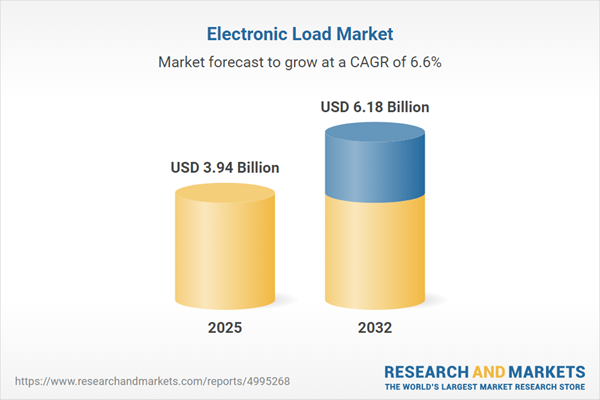Speak directly to the analyst to clarify any post sales queries you may have.
Electronic loads are vital tools for stress-testing advanced power systems, supporting the stringent performance and safety requirements found in today’s competitive technology markets. This report provides a strategic roadmap tailored for senior executives seeking actionable insights on the evolving electronic load market, its regulatory impacts, and growth opportunities across industries.
Market Snapshot: Electronic Load Market Size and Projected Growth
The global electronic load market is experiencing steady expansion as innovation in power testing drives demand for precision emulation and validation tools. Growth is shaped by rapid shifts in critical end-user sectors, with notable investments accelerating development cycles and fueling market advancement across continents. The report’s market sizing and compound annual growth rate provide a clear baseline for strategy and planning.
Scope & Segmentation of the Global Electronic Load Market
This report comprehensively analyzes the market across key segmentations and regional clusters, ensuring stakeholders can address evolving requirements and gain targeted insights:
- Voltage Ratings: 600 V & Above, Below 600 V
- Load Capacities: 100W to 1KW, 1KW to 5KW, Above 5KW, Below 100W
- Device Types: Bench Top, Modular, Rack Mount
- Applications: Battery Testing, Energy Storage Systems, Power Supply Testing, Transistor Testing
- End User Verticals: Aerospace & Defense, Automotive, Consumer Electronics (including Smartphones, Wearable Devices), Healthcare (Diagnostic Equipment, Medical Devices), Renewables (Solar Energy, Wind Energy), Telecommunication (Data Centers, Networking Equipment)
- Regional Coverage: Americas (United States, Canada, Mexico, Brazil, Argentina, Chile, Colombia, Peru), Europe, Middle East & Africa (UK, Germany, France, Russia, Italy, Spain, Netherlands, Sweden, Poland, Switzerland, UAE, Saudi Arabia, Qatar, Turkey, Israel, South Africa, Nigeria, Egypt, Kenya), Asia-Pacific (China, India, Japan, Australia, South Korea, Indonesia, Thailand, Malaysia, Singapore, Taiwan)
- Company Profiles: Extensive analysis of leading solutions providers including AMETEK, B&K Precision, Keysight Technologies, Chroma ATE, ITECH ELECTRONIC, National Instruments, Tektronix, Rohde & Schwarz, and other market participants
Key Takeaways for Decision Makers
- Programmable electronic loads enhance reliability testing and accelerate time-to-market for products in dynamic, high-growth verticals.
- Emerging technology frontiers, such as electric mobility and renewable integration, are redefining testing requirements and influencing product development strategies.
- Modular architectures and software-driven platforms improve laboratory efficiency, allowing rapid adaptation to changing regulatory or application-specific needs.
- Cloud-enabled environments facilitate remote monitoring and predictive maintenance, supporting global collaboration and data-driven decision-making.
- Customization and service differentiation remain central to competitive positioning, especially as end-users seek integrated testing and analytics solutions.
Tariff Impact on Electronic Load Market Dynamics
New tariff measures announced for the United States in 2025 are having a tangible impact on global supply chains for electronic load components. As costs rise for imported semiconductors and related modules, manufacturers are reevaluating sourcing strategies to mitigate risks and control expenses. This environment is prompting a shift toward nearshore or domestic procurement, and increased collaboration between engineering and procurement functions to ensure resilience and streamline cost structures. Investments in automation and supply chain optimization are further shaping competitiveness in an evolving regulatory climate.
Methodology & Data Sources
This analysis is built on a mixed-methodology approach combining primary interviews with senior test engineers, product managers, and procurement professionals, along with a review of secondary sources such as technical whitepapers, regulatory releases, and supply chain data. A validation process involving expert advisory input ensures data accuracy and actionable recommendations for strategic planning.
Why This Report Matters
- Enables benchmarking of product and service strategies in a fragmented global market.
- Provides clarity on regulatory and tariff impacts, helping executives anticipate and respond to disruptive shifts in supply and pricing.
- Equips decision makers with granular segmentation insights and region-specific trends critical for portfolio optimization and targeted market entry.
Conclusion
The electronic load market is advancing at the intersection of technology innovation, regulatory change, and diverse industry application. By leveraging the insights in this report, senior leaders can confidently navigate disruptions, refine offerings, and position their organizations for sustainable growth and resilience.
Additional Product Information:
- Purchase of this report includes 1 year online access with quarterly updates.
- This report can be updated on request. Please contact our Customer Experience team using the Ask a Question widget on our website.
Table of Contents
3. Executive Summary
4. Market Overview
7. Cumulative Impact of Artificial Intelligence 2025
Companies Mentioned
The companies profiled in this Electronic Load market report include:- AMETEK, Inc.
- B&K Precision Corporation
- CHANGZHOU BEICH Electronic Technology Co., Ltd.
- Chroma ATE Inc.
- EA ELEKTRO-AUTOMATIK GMBH
- Good Will Instrument Co., Ltd
- Helios Power Solutions Pty Ltd
- Hillstone Products Ltd
- ITECH ELECTRONIC CO.,LTD.
- Keysight Technologies, Inc.
- Kikusui Electronics Corporation
- Magna-Power Electronics
- Matsusada Precision, Inc.
- National Instruments Corporation
- PRODIGIT ELECTRONICS CO., LTD.
- Rigol Technologies
- Rohde & Schwarz GmbH & Co KG
- RS Components Ltd
- Spellman High Voltage Electronics Corporation
- Tektronix, Inc.
- Teledyne Technologies Incorporated
Table Information
| Report Attribute | Details |
|---|---|
| No. of Pages | 196 |
| Published | November 2025 |
| Forecast Period | 2025 - 2032 |
| Estimated Market Value ( USD | $ 3.94 Billion |
| Forecasted Market Value ( USD | $ 6.18 Billion |
| Compound Annual Growth Rate | 6.5% |
| Regions Covered | Global |
| No. of Companies Mentioned | 22 |









